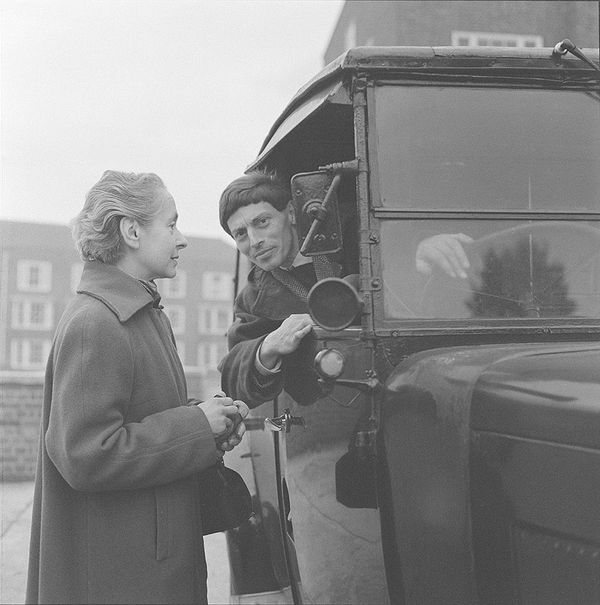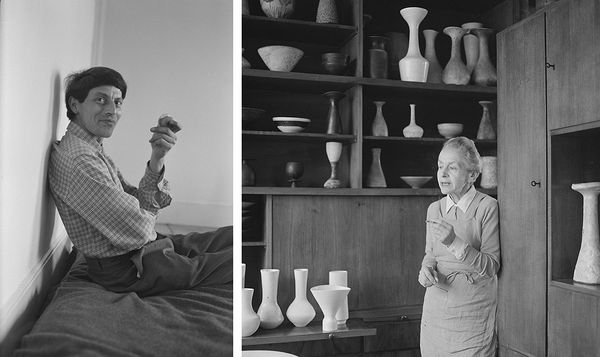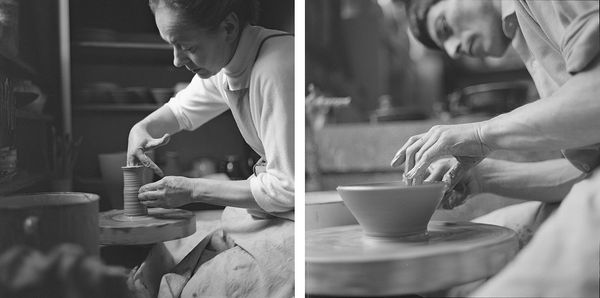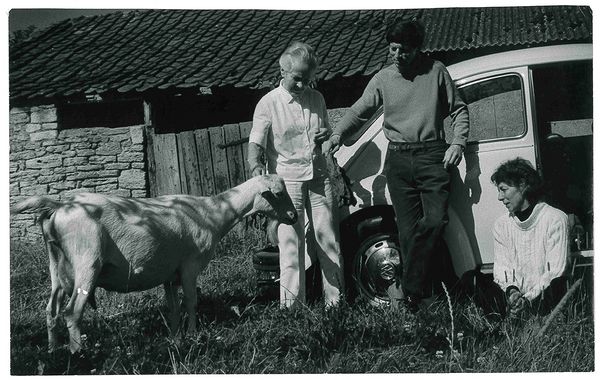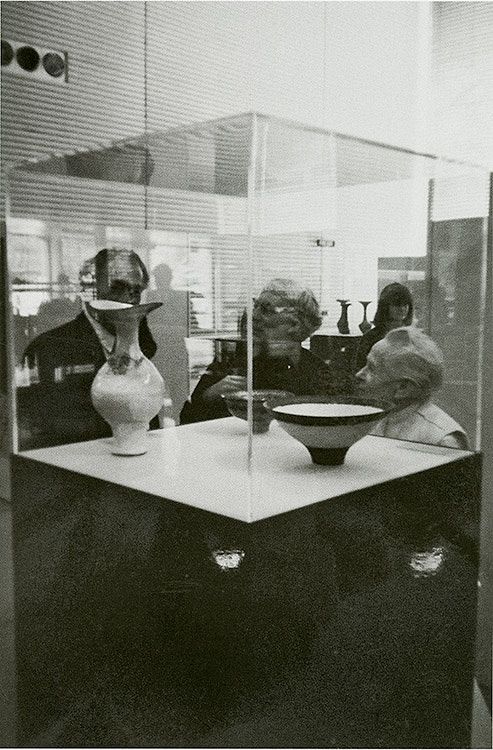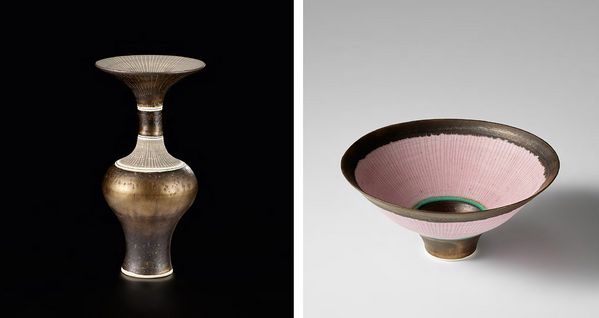Lucie Rie and Hans Coper. © Jane Coper.
Here, writer David Whiting takes us on a tour of the interstices and intersections behind the two phenomenal collections coming together in Phillips' much-anticipated 1 November 2023 ceramics auction in London — Lucie Rie and Hans Coper, Exceptional Ceramics: Selections from the Estate of Jane Coper and the former Collection of Cyril Frankel. View catalog.
There is simply no precedent for these two major collections of Lucie Rie’s and Hans Coper’s work, ones so intimately connected with such significant protagonists at the very heart of these two potters’ lives. The two together are a legacy in pots that marks and delineates artistic partnerships, specifically that of Jane Coper with her husband Hans, of course, and then with their life-long friend Lucie Rie, as well as Cyril Frankel’s own close association with Lucie and his deep admiration for what Hans achieved. Here are objects inextricably linked with the personal lives of these artists. We have many of the definitive forms here, with some pieces that are unique and unrepeated. In Jane Coper’s case they were the Coper pots which she and Hans lived with daily, favorites, perhaps prototypes or one-offs, some that were kept and valued but developed in other ways. And then there were the many treasured gifts from Lucie over the years.
(Left) Hans Coper © Jane Coper, and (Right) Lucie Rie © Jane Coper/Estate of the Artist.
Cyril Frankel too had an unerring eye, and after his initial purchases, many of his pots by Lucie were presents from her that marked special occasions in his life. He eventually acquired choice works of Coper’s that complemented these, appreciating both potters’ nuanced understanding of what clay could achieve and how their work was as much grounded in tradition as it was about twentieth century space and living. Cyril too owned pieces we have rarely if ever seen elsewhere, with surprises that add much to our knowledge. And both of them — Jane through her poetic photography and Cyril through his curation and writing — did much to influence and shape our appreciation of Lucie’s and Hans’s achievement. Jane’s images, filling various publications, particularly the two important biographies about the potters written by Tony Birks in the 1980s, are definitive interpretations, and Cyril, in his later life, saw it as his mission to promote and celebrate figures who had helped bring such a refreshingly Modernist, very European aesthetic into British cultural life.
Jane Coper (1932–2022) was born in London, the daughter of Barbara Nicholson (1906–1978), the distinguished botanical illustrator, well known for her familiar books on flowers and trees for Oxford University Press. Jane attended the Elmhirsts’ progressive school at Dartington in Devon, where she met her first husband Ulf Simon Gate, successively a TT motorcycle racer and commercial pilot, and they subsequently began a family, but the marriage was brief. She went on to study photography at the London College of Printing, at which time, in 1954, she first met Hans, then still working with Lucie Rie at her Albion Mews pottery, near Marble Arch. She became a regular visitor here, and found in Hans a willing model for her photographic portraiture, giving Jane the practice she needed, and the rest of us some insightful early images of the attractive young potter. It was to lead in the following years to an extraordinary body of photographs not only of the man, but more specifically a record of his art as it was made and completed, and of his working environment too.
(Left) Lucie Rie at the wheel © Jane Coper/Estate of the Artist and (Right) Hans Coper at the wheel © Jane Coper/Estate of the Artist.
These meditative pictures went beyond documentation, conveying the filtered light, atmosphere, and detail of his successive studios. There was a particular softness about her lens which gave a true sense of these pots’ enigmatic qualities and how they could enrich and enhance their settings. When seen in haunting multiples, in richly toned black and white, his pots took on added sculptural dimensions, standing in their own silence. These were aspects she brought to Lucie’s work too, Jane’s intuition conveyed a texture that showed an appreciation of the more mysterious elements of shape and surface, and of how each piece related to and complemented another. These objects had a presence, strong in isolation, but memorable too in collective conversational groupings.
Hans Coper in his Digswell studio. © Jane Coper/Estate of the Artist.
Jane’s close visual chronicling of Hans’s pots as they evolved indicated how much her life was now devoted to his work and well-being. Her own professional career, as Jane Gate, inevitably came second, but after leaving college she worked for some years as a freelance photographer in advertising, illustrating magazine food recipes for example, as well as book projects that included illustrating a school’s literary anthology, Come Down and Startle (1968), and, much later, a more personal project with Adrian Slack, Carnivorous Plants (2000), reflecting a life-long love of botanical subjects she had inherited from her mother. In 1963, she made a memorable trip to Japan and India, using her camera to document these countries, the everyday life, the people and places. At home, she helped to create a wonderfully idyllic upbringing for her children, particularly after she fulfilled her long-held wish to move from London to the country, the family settling in Frome in Somerset in 1967. This place gave Hans more privacy, and she could concentrate on her weaving and gardening, the rearing of goats, and the welcoming of their many friends, including Lucie Rie of course. Jane and Hans finally married in 1974, and after his death seven years later, she eventually returned to live in her late mother’s old house in Donhead St Mary, on the borders of Wiltshire and Dorset, continuing to take photographs for personal pleasure and enjoying her famous family of dogs, who accompanied her to a final home near Bath.
Lucie Rie, Hans Coper and Jane Gate at Spring Gardens, Frome, Somerset, 1972. © Photography by Stella Snead. From the Crafts Study Centre, University for the Creative Arts, RCC/3/6.
Jane was a highly spirited, perceptive, and straight-talking woman who was also extremely generous and funny. She had a self-effacement that deflected any focus on her own life and contribution. Other people were more important. Typically, when Lucie Rie died in 1995, she got to the heart of the matter about her old friend, saying ‘Lucie did not waste anything. Not just material things, but also her time, energies and emotions. She said, “I am a potter, what else shall I do?” Could this discipline be the secret of how she had time for us and still time for her amazing pots? Lucie’s explanation was “but I am never tired when I make pots.”’ Then in 2020, Jane’s previously unseen photographs formed the basis of the catalogue accompanying the centenary exhibition Hans Coper 100 at the Ashmolean Museum, Oxford — several loans to which are now in the present sale. Again the images, of pots finished or in the making, some with Hans in shot, demonstrated her special empathy, her ability to give evocative insight into an artist’s sense of workplace into their broader creative world and imagination.
Lucie Rie in her Albion Mews studio. © Jane Coper/Estate of the Artist.
Cyril Frankel (1921–2017) had a long and distinguished career as a director and filmmaker before he became involved in studio ceramics. However, the seed was very much sown in earlier years, when he purchased a piece of Lucie Rie’s work from the Berkeley Galleries in London in 1953, and, taken by a friend, he first met her at Albion Mews the following week. So his collecting started. Born in Stoke Newington, London, his role as a director began soon after he was de-mobbed from the army, establishing himself in the 1950s with documentaries made for the Crown Film Unit. In 1954 came his first feature, Devil on Horseback, starring Googie Withers, which launched a prolific film career. It was closely followed by his pioneering drama documentary, Man of Africa, in 1954, shot in Uganda and the first British film to feature an all-Black cast. Other projects included No Time for Tears with Anna Neagle (1957) and On the Fiddle (1961), with an early role for Sean Connery. He directed both drama and comedy into the 1960s, the former including some off-beat horror for Hammer, notably The Witches (1966), as well as moving into more television with shows such as Gideon’s Way and The Avengers and, at the end of that decade, the equally cultish Randall and Hopkirk, Deceased. He then directed episodes of other series now enjoying a similar revival of interest. These included Jason King, which starred the late Peter Wyngarde, and The Adventurer, featuring Gene Barry. He was proud of Timelash, a technically complex episode of the science fiction show U.F.O., which involved — quite literally — putting the actors in a state of suspended animation in one sequence. In 1975 came another movie, the spy thriller Permission to Kill, with Ava Gardener and Dirk Bogarde. Later in life, he was to concentrate on another love, occasional theater direction.
Cyril Frankel, Jane Coper and Lucie Rie at Lucie Rie’s retrospective exhibition at the Sainsbury Centre for Visual Arts 1981. Featuring Lot 406 Lucie Rie Late mallet- shaped vase, Lot 310 Lucie Rie Footed bowl and Lot 306 Lucie Rie Footed bowl. © Sainsbury Centre, UEA / Estate of the Artist.
Cyril was a pioneer in arts coverage, working on the BBC’s acclaimed flagship Monitor series (1958–65), which provided a good basis for his cultural documentaries in the 1980s, subjects that included the Old Vic Theatre, the music of Fauré, and then, in 1982, his memorable BBC Omnibus film about Lucie Rie, made to coincide with her retrospective at the Sainsbury Centre and the Victoria and Albert Museum (in which the following works featured: Lot 301 Lucie Rie Small footed bowl, Lot 303 Lucie Rie Vase with flaring lip, Lot 306 Lucie Rie Footed bowl, Lot 355 Lucie Rie Vase, Lot 357 Lucie Rie Large rounded bowl, Lot 371 Lucie Rie Early squared pot and Lot 375 Lucie Rie Oval cylindrical vase).
Lot 303 Lucie Rie Vase with flaring lip and Lot 306 Lucie Rie, Footed bowl.
Presented by David Attenborough, Cyril’s film not only gave insights into Lucie’s character and her working approach, but like Jane Coper’s pictures, it evoked the special atmosphere of her London studio, silent and hidden just a few minutes’ walk from the busy Edgware Road. It was a place where her daily almost meditative dedication to the art of pottery had been practised over forty years. And so Cyril’s established interest in studio pots and his flare for promotion led to a second career, initially working as a ceramics consultant for Christie’s and Sotheby’s. He was particularly keen to reintroduce regular specialist sales that were entirely devoted to modern potters and began organizing more ambitious auctions after he moved to Bonhams in 1988 — projects in which Lucie and Hans would be the star players, along with other important makers like Bernard Leach, Shōji Hamada, and Michael Cardew, as well as students of Lucie’s and Hans’s such as Ian Godfrey, Ewen Henderson, and Elizabeth Fritsch.
Lucie Rie was virtually angelic. The beauty that she was putting out into the world, was only a reflection of her own spirit.
—Cyril Frankel
With his informative and generously illustrated catalogues and his belief that, with his sense of theater, sales should be great events, Cyril was putting contemporary work center stage — and he began to achieve record prices for Lucie and Hans in particular. This activity generated various important curation projects in the years ahead, beginning with a beautifully presented show in Japan, Issey Miyake Meets Lucie Rie, in 1989, which was designed by Tadao Ando. There followed a display at the Sainsbury Centre, Norwich and Fitzwilliam Museum, Cambridge concerning Lucie’s and Hans’s significance as catalysts, Lucie Rie, Hans Coper and their Pupils (1990), though the exhibition was more about looser influence than any direct teaching relationships. It was an idea that was subsequently developed in Cyril’s book about the Lisa Sainsbury Collection, Modern Pots; Hans Coper, Lucie Rie and their Contemporaries, published in 2000. In 1994, he co-curated an exhibition at the Metropolitan Museum of Art, New York, Lucie Rie and Hans Coper — Masterworks by Two British Potters. Three years later, after her death, he was to organize the poignant sale of the remaining contents of Lucie’s studio. Then finally, in 1999, the year he became a consultant at Phillips, there was Lucie Rie Gebrannte Erde at MAK, Vienna, the place of her birth. It was in a sense Lucie Rie coming home, as she had resisted exhibiting there after leaving the city in 1938.
No one who met Cyril Frankel, who finally retired in 2001, is likely to forget him. He was something of an impresario and showman who threw a great deal of energy into his projects. He was a complex man who possessed a quick wit, someone also capable of great kindness and sensitivity. He brought his acute visual and directorial skills to the art world too, and the pots we see here reflect the high standard of his personal commitment to clay and what it, in the hands of its finest practitioners, could offer, and he wanted to share this with us all.
Artist Edmund de Waal puts Lucie Rie in conversation with Hans Coper as he explores the upcoming auction of Property from the Estate of Jane Coper and the former Collection of Cyril Frankel.
The writer is much indebted to Kevin Gate for his assistance in the writing of this essay.
Discover More from Design, London >
Recommended Reading
